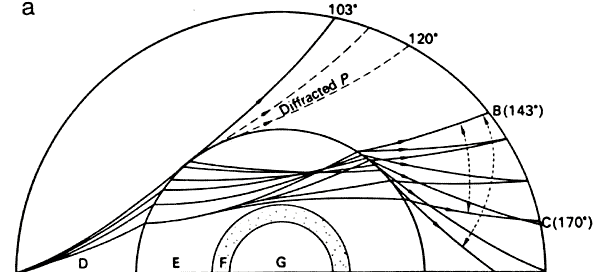
There are cultural claims supporting a hollow earth and then my own work on cloud cosmology and the three tiers of matter led me unwillingly there as well. My physics explains why this can be true.
Now we have a chap who has taken the conjecture and really tested it against our known data and models and finds that the Hollow Earth theory is the best fit.
Thus had i never heard of Newton i would have had no problem accepting all this.
The most important take home here is that the shell is around 700 kilometers thick. Better yet, it is all pretty rigid rock and not molten at all. It is essentially homogeneous. This was unexpected, but it is also nice to toss those complications. We can actually project a tunnel system going through to the inner shell as not utterly implausible. I did not expect to end this day with that particular conclusion and insight.
That science does not understand gravity is also an obvious conclusion and one i already hold. In fact 98 + percent of gravitational potential is carried by so called Dark Matter or what i have named and identified as second tier matter and it is scaled at the level of the electron. Thus third tier matter acts mostly as a wave guide or natural vessel for this matter.
So in fact all the prior science supports a hollow earth conjecture.
Hollow Planet seismic model
by Jan Lamprecht
https://www.bibliotecapleyades.net/tierra_hueca/esp_tierra_hueca_9.htm
Let me show you how my Hollow Planet seismic model can explain the Earth's seismology better than the existing solid Earth seismic model - and yet not one person at any university has shown the slightest interest in this.
The purpose of this page is to demonstrate a number of most amazing things about seismology to the Reader in the clearest and simplest manner possible. When I wrote my book I did delve into the many deeper and more technical aspects but I want to put that aside for now.
The purpose of this exercise is to show people visually a number of very important things which you will not find in any book on earth. (Note: This material lends itself to a TV/documentary presentation and I have tried unsuccessfully for the last 2 1/2 years to get someone to take some of my material and show it on TV because I believe it will blow people's minds). The solid Earth model is divided into three major segments (we will ignore the smaller ones as they do not affect the bigger picture).
Those segments are (from the centre) :
the Inner Core
the Outer Core
the Mantle
Lesson #1: The Earth is NOT a ball of molten lava
The first question everyone asks me when they hear of the Hollow Planet idea is: "Where does lava come from then?" The (completely FALSE) impression schools have created in everyone's minds is that the Earth is this red-hot ball of lava. They then imagine that lava from volcanoes comes from the centre of the Earth.
Ask any geologist or seismologist if this is true and you will discover they disagree. Standard geology and seismology texts tell a different story. Scientists know that most lava is slightly radioactive and they believe it is produced either by decaying radium (decayed uranium) or through stresses in the crust. Lava is created by heat generated within the crust of the Earth. The crust is said to be no more than 20 miles thick, although to be honest nobody has ever actually penetrated the crust so we really do not know what (if anything different) lies beneath it. Scientists will tell you that lava is a crustal phenomenon and all lava comes from no deeper than 20 miles down.
If the Earth were an "ocean of molten lava" then it would actually be subject to tidal pressures and the continents would be broken to pieces as the earth rotated. Scientists say the Earth is actually composed of solid rock for the most part. As you go deeper, the pressures are supposed to be so great that the rock actually flows from extreme pressure. (As you will see, even this may not be really true). But nowhere in modern geology or seismology will you see them saying the Earth is a ball of molten lava.
In fact, the final proof comes from seismology itself. When an earthquake occurs, seismic waves travel out in all directions throughout all the earth. There are two types of seismic waves: P and S. Based on this, scientists know that all of the earth is actually quite RIGID and composed only of rock. The only partial exception is the Outer core. Take a look the seismic diagram below.
If the earth were truly molten, then seismic waves would be considerably dampened down. So the fact that seismic waves can travel through and around the earth shows that it is mostly completely rigid and solid.

In the above seismic diagram (from a text book on seismology), D=Mantle, E=Outer core, G=Inner core.
Lesson #2: Traditional Hollow Earth ideas fail the "seismology test"
Let me show you why scientists simply laugh at the idea of a Hollow Planet. Keep in mind that all Hollow Earthers have, for more than a century, been saying that the Earth's crust is 800-1000 miles thick.
Note in the above diagram, that seismic waves travel from the source of an earthquake (on the left) through the Earth at various angles and therefore reach the other side (this is not true of all seismic waves, but of the main ones, referred to as "P" waves). If you were to propose that a planet only has a crust of 1,000 miles or less, then this is why a scientist would laugh at you. See the image below.

In the above diagram you can see the seismic ray paths (red lines) moving away from an earthquake source. Note how the huge cavity in this "traditional" hollow earth model would block out all the "P" waves from reaching the other side of the Earth. So clearly, this type of approach does not fit the known scientific facts and so we must discard it.
Lesson #3: Is there any Hollow Earth seismic model which allows waves to go around the Earth?
The obvious problem posed by the theory is that seismic waves actually reach right across to the other side of the Earth. Scientists are therefore quite confident that the P waves must have passed through the core of the Earth and this tells them that there cannot be a cavity.
When I did my feasibility study (which is what my book is), I looked at the problem from every conceivable angle to see if there was any Hollow Earth model which made seismic sense. I found only one - I repeat - only one, which has any merits. All other Hollow Earth seismic models are failures. Take a look at it below.
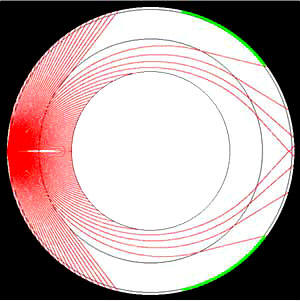
In the above model, I simply used the Earth's structure as scientists define it now. I replaced the Outer Core with a cavity (I'll explain why later - because there is a sound reason for it). But the thing I changed was the structure of the Mantle. I wondered what would happen if density within a sphere did not increase uniformly as has been assumed.
What if density actually DECREASES from a certain point onwards? You will notice all solid-earth seismology shows ray paths curving in a "U" back to the surface of the Earth. That is because density and pressure increases as you go deeper. But if, for some reason, density were to suddenly decrease, then the waves would curve in the opposite direction! I realized this, and you can see what then happens. In the middle of the Mantle, where density suddenly decreases, it causes seismic waves to travel around the cavity - right to the other side of the Earth!
You would be excused for believing that the waves might have passed through the core of the Earth when in fact nothing of the kind happened.
Lesson #4: The Mystery of the "Shadow Zone"
The next problem in global seismology is explaining the mysterious "Shadow Zone". There is a lack of P waves between 103o-144o from the epicenter of a quake. Take a look at the problem as seen from a university-level text-book on seismology.
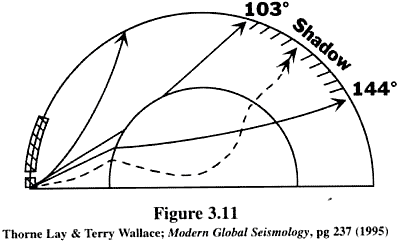
Note how the P waves strike the Outer Core and scientists believe the refraction caused by this sudden change in density can explain the shadow. But notice, in this university-level text book how they are befuddled because there are still some waves which reach the shadow zone (dotted line).
They are at a complete loss to explain this. Now let me explain to you how perfectly my Hollow Earth model solves this problem. Take a look at the image below.
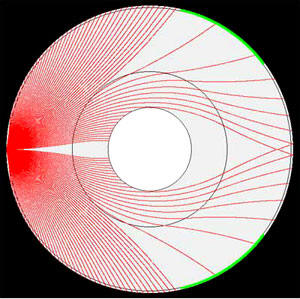
After changing some parameters in my Hollow Planet seismic model, I have a "Shadow Zone" which matches the facts exactly! I made the cavity smaller, and I moved the "point of maximum density" (the dark circle in the Mantle) somewhat lower. Note: The Green area near the surface is the "Shadow Zone". Now look at the amazing thing that happens.
We have P waves behaving as normal right up to 103o. Then suddenly there are very few of them inside the Shadow Zone and then after the Shadow Zone we are a greater and greater number of ray paths eventually converging on the other side of the Earth! This is exactly consistent with the known facts of global seismology!
Sometimes small things can make a huge difference. It is obvious from the Hollow Planet diagram why there would be a Shadow Zone. This is caused by the gradual change from "increasing density" to "decreasing density." This causes the waves to "split" - some to go down while others go up. So there has to then be an area on the surface which receives less seismic waves than normal - hence the "Shadow Zone."
A really crucial point is that the "Shadow Zone" is not completely devoid of waves. In the Hollow Planet model you can see why - it makes perfect sense. In the solid earth model you can see they have to stretch their imaginations (dotted lines) in order to try to find some explanation. In their diagram they believe the Shadow is cased by sharp refraction - but clearly that explanation does not quite fit the facts.
Lesson #5: Proving, that the Outer and Inner cores - do not exist at all
You have been wondering why I removed the Outer Core altogether from my Hollow Planet seismic model. The answer is simple. There are two kinds of seismic waves - P waves - which are much like sound waves.
They are pressure waves caused by a direct "push" through the matter. But then there are S waves - shear waves - which are like taking a piece of hose-pipe and moving it up and down rapidly. P waves can travel through everything except a vacuum (although if they traveled through air they would be considerably weaker than when they traveled through rock or a liquid). S waves however, can only be transmitted through rigid materials - like rock.
It has long been known to scientists that unlike P waves which can travel around the world - S waves are in fact "blocked" by something. They named this "something" the Outer Core. They decided the Outer Core had to be non-rigid. If the Outer Core were a type of "liquid" then P waves could pass through it, but S waves could not. Hence they "invented" the Outer Core. Very early on, when I became interested in the Hollow Earth idea, I realized this property of the Outer Core, and I wondered if the Outer Core was really a liquid, or if it was, in reality a cavity. My big problem however was figuring out how P waves behaved.
Now let me show you that the Outer Core does not exist at all, while the Inner Core is merely the part of the Earth in the immediate vicinity of the cavity!
Here we have a standard solid-Earth seismic model.
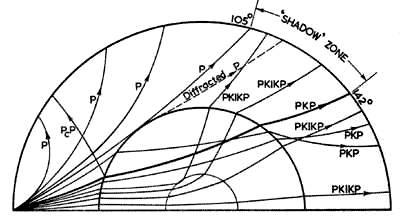
The waves we are interested in are those which passed through the core - the PKP and PKIKP waves. When one takes a look at the data showing the speed with which seismic waves travel, one discovers an interesting thing: Waves which pass through the Core (those which are supposed to be going in a straight line) actually slow down! What makes this even more curious is that P waves are supposed to speed up when they pass through dense material.
And there is no place on this planet which is as dense as the Inner Core! So why do P waves then slow down? According to the formula for the transmission of sound/pressure waves - speed is affected by two factors: (a) Density (b) Elasticity. This gives scientists a way of getting out of the problem by saying: "If the Density has increased, but the wave has slowed down, it must THEREFORE mean that the Elasticity increased."
Let us return to my Hollow Planet seismic model.
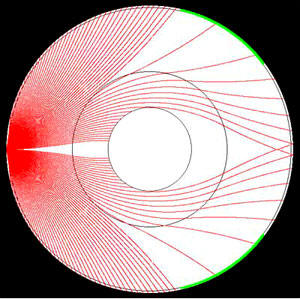
Take a look at the ray paths of the waves which reached the other side of the Earth, beyond the Shadow Zones. Look at the paths they traveled.
(a) They did not travel through the core - they took a longer path around the cavity/core
(b) They were the waves which traveled near the cavity - hence near the area of lowest density!
Both those factors would cause the waves to take a longer time to travel to the other side of the Earth, hence, giving the appearance that they slowed down, while apparently traveling in a more-or-less straight line!! There, once more, we find a perfect match between my Hollow Planets Seismic model and what we know about global seismology.
As you can see, this explanation accounts for everything observed and yet there is no need for either an Outer or Inner Core.
Lesson #6: Amazing Seismic Speed Revelations - proving the Earth is homogenous
Seismologists often produce diagrams such as the one below which show the speed of seismic waves inside the Earth at various depths.
\

You will notice, at various depths, such as at the 5,000 Km level, the speed of waves changing very sharply - either speeding up or slowing down. Scientists look at these sharp changes in speed and then state that this is due to sharp changes in density.
They use this to "prove" that the Mantle is composed of a different type of material to the Outer Core and so forth. You have seen the Hollow Planets seismic model and how radically a seismic ray's path may differ from the solid Earth model. Supposing the Earth really is hollow, it would then follow that the paths of waves differ in reality from what scientific theory supposes.
That being the case, scientists may suppose a certain ray speeds up or slows down when in fact it does nothing of the kind. If they knew the right path (like the rays going through the core for example), then it might turn out that such rapid speed changes never actually occur.
However, since scientists are obsessed with the need to have a model which matches the 6 trillion tons needed (according to their gravity experiments), they need to find a way of "packing lots of matter into the Earth". So they are looking for evidence of changes in density. I'm sure that when they find they have to account for certain behavior by postulating such instantaneous increases/decreases in speed that it makes them confident they are on the right track. But the opposite may be true. It is entirely possible that if one knew the exact paths of the rays that one would find the speed of seismic waves would not vary that much.
This is a most important point. It would mean that my Hollow Planet seismic model is internally consistent. In other words, it postulates that the Earth is homogenous, and a resultant analysis of seismic wave speeds along the paths postulated should then prove that indeed the Earth is homogenous.
This would be a further proof that my model is the right one and not the solid earth model.
Lesson #7: Deep Quakes may disprove the Solid Earth model
According to scientists, pressure increases with depth. According to their calculations the pressure is so great that between 70-150 Km down, all rock will begin to flow. Below 150 Km there is no known material which will not flow.
Therefore, according to scientists, there can be no earthquakes with epicenters deeper than 150 Km - because it is IMPOSSIBLE!
But there are! Tens of thousands of Earthquakes have epicenters deeper than 150 Km. The histogram below shows some curious things.
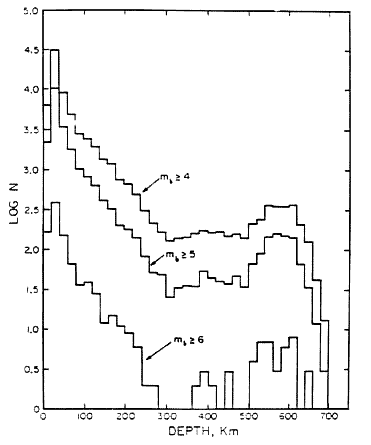
It shows that earthquakes occur right up to a depth of 300 Km down.
The picture is somewhat consistent with science's expectations because there are less quakes with depth (though they do not stop at 150 Km as expected). Then a most curious thing happens, they increase in number up to a depth of 700 Km where they end. Scientists try to explain these quakes by invoking various possible strange properties of matter. Although each theory advanced so far has had problems with it.
What no scientist on Earth is willing to accept is that maybe gravity does not behave the way they believe it does! That histogram may be the proof that gravity does not behave as is expected at depth. Why can't scientists look at that histogram and see it for what it might be telling us? That histogram may be "stating" quite clearly that the Earth does not have those pressures inside and that it remains relatively cool down to incredible depths? Maybe that diagram is "telling us" that gravity does not behave at depths the way we are expecting. If that is so, then everything we think we know about the mass of the Earth may be wrong.
Note, gravity is a very weak force and even a bit of static electricity could produce an attraction far in excess of anything gravity could produce - but with a fraction of the mass. If that is the case, you don't need to worry about the Earth having to have a mass of 6 trillion tons. It may weigh considerably less.
As final note, it may be that there are quakes deeper than 700 Km but they are so far away, and maybe the effects of gravity are so weak that they do not have enough force for us to detect them.
Let me point out that seismologists have indeed speculated about the possible existence of "Silent Earthquakes" which are remain undetected by our equipment.
Occam's Razor the Hollow Planets model:
When in doubt, the simplest model is probably right
There is "rule" in science known as Occam's razor. Occam's Razor is a little piece of logic which states: When choosing between two or more theories it is most likely that the simplest explanation is the correct one.
You have now seen my simple "sandwich" Hollow Planet model, which assumes the Earth is largely homogenous in composition, and you have seen how this simple model can match and even better the achievements of the more complex and unwieldy solid-Earth model. Does this idea of mine not satisfy Occam's Razor much more than the solid-Earth theory does?
I received an e-mail one day from someone studying at an American university. He said to me that he had never met such a closed-minded group of people as the Professors at Universities! Well, I would tend to agree with him. My book was published in July 1999. I sent copies to universities and I placed my book on the desks of university lecturers and Professors. Not one of them spent so much as 10 minutes looking at my book. After leaving my book there for weeks I eventually just gave up. Now I don't bother trying to win academics over.
My book is subtitled "A Feasibility study of possible Hollow Worlds" - and that is what it was. I wrote it because I was certain I could actually contribute something, and I truly hoped some academics or scientists would take an honest look at it. I thought if anyone would appreciate some original lateral thinking, it would be them! How wrong I was! The seismic diagram was the most important thing in it. I wanted scientists to compare my theoretical model against theirs and to match the seismic data to it.
I was convinced it was superior to the complex solid earth model. It seemed to me to be a similar situation to the many concentric orbits which were used to explain the orbits of planets until it was discovered that orbits were really elliptical. Too bad there aren't any open-minded people in universities anywhere who would take a bit of their time to take a look at my Hollow Planets Seismic model and to compare its seismic predictions with those of their solid Earth models.
I'll bet they would be very surprised by the results.
2 comments:
Now al that you have to do is explain how this hollow earth formed. I mean other than it is an artificial, manufactured thing by aliens or god or your own favorite non natural, nonhuman thing
I hardly disagree, which is why i dismissed this whole paradigm forever.
however, in developing my cloud cosmology we ended up with three tiers of matter. We perceive the third tier and dark matter happens to be the second tier. That is an incompressible fluid that carries almost all our observed gravity.
Then i had to think about the nature of the first tier of matter which is also the tier of continous creation and whose gravity is again many orders of magnitude greater, but at extremely close range.
Producing a void in the dark matter allows an inflow to the center which then ignites to produce both dark matter and third tier matter as well. all that is pushed away to form an expanding shell around the ignition point.
This means that all large planets and stars are actually hollow.
Needless to say i do not want to believe my own work either.
Post a Comment